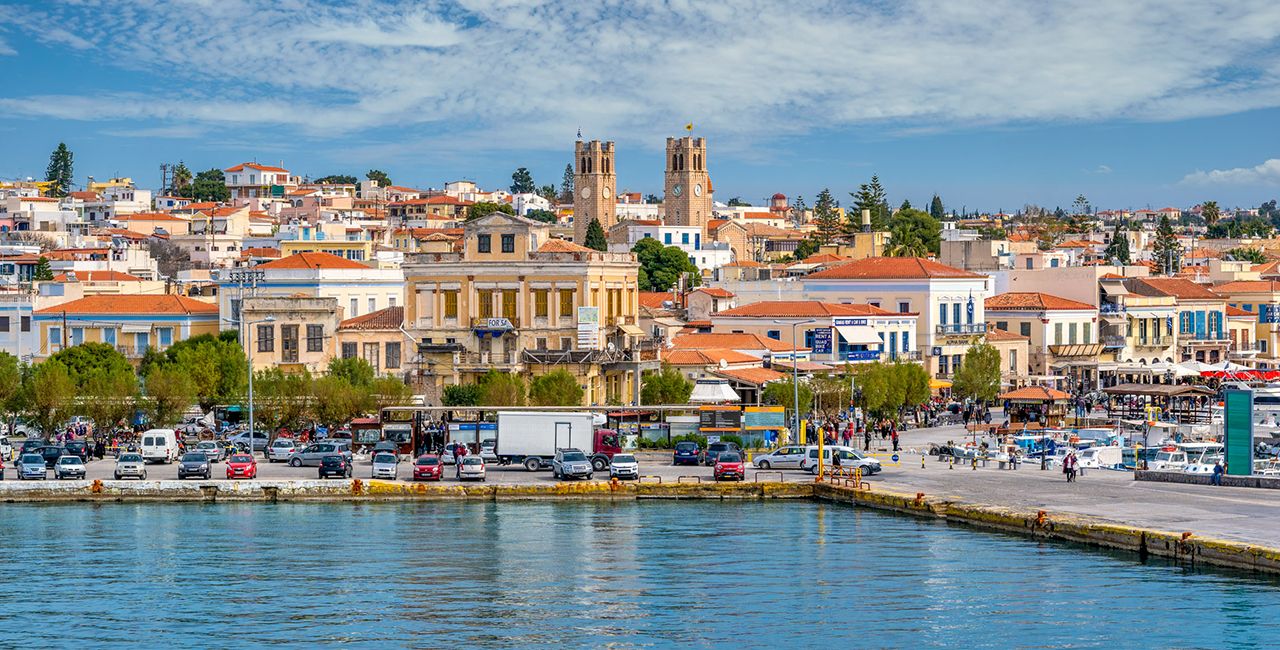
Aegina Town
The city of Aegina is the capital city of the island and it's located on the west side.
It's built amphitheatrical towards the sea. When you enter the harbor, the small, white church of Saint Nikolas welcomes you.
Your first impession is the modern type classical buildings, which are located along the sea front of the island and have terristrial shade colors which make them look even more beautiful at sunset. The economic and social life of Aegina is centralized on the coastal road and the parallel roads.
Take a ride on the horses and the carriages, walk in the narrow, paved streets and see the traditional houses, the churches with the blue domes and the shops with folk art.
Don't miss seeing the fish-market, the traditional restaurants that serve snacks with ouzo (a greek drink). Also the fishing boats, that are not only used for fishing but for seiling groceries as well. And finally don't forget to buy the famous peanuts of Aegina.
Enjoy eating fresh fish and traditional food in the fish restaurants in Aegina. Also, enjoy the patisseries which are in front of the harbor and in the beautiful alleys where you can have a cup of coffee or a drink.
In the enchanting atmosphere of the night you can have fun and dance at the clubs in town. The buildings in Aegina have a neoclassical architecture with folk elements. They were built during the 19th century and they remind us that Aegina were once the capital city of Greece for two years.
Aegina is well-known for its history and for its art and craft events that take place there. The beauty of the island is undisputable and for many decades, many greek and foreign artists and literary writers preffered to visit this island. On the ground floor in many of these buildings, there are traditional coffee shops, patisseries, restaurants, shops and banks.
In the narrow streets of the island there are colourful houses and beautiful flowers along with picturesque shops and taverns. The town of Aegina is beautiful, picturesque and it curiously evokes the visitor.
In the yard of Saint Dionisious cathedral church in Aegina, there is the Eunardio school which was a teacher's school the past century. It was there, where the first greek goverment took place after the greek revolution in 1821. In the Metropolis street, we come across the library in Aegina and further down the street the Kapodistriako goverment House in which, on the groundfloor, was the first mint.
In the same street we can see the houses of many famous artists and others like Zografou, Peppa, Liberopoulou and also Markello's tower. Northern is Logistatidi's mansion and the first cathedral in Aegina. The cathedral was a christian basilica of the 5th-6th century with a mosaic floor in which the foundings and baptism areas were saved.
In the out skirts of the town there are archaic tombs, tombs of the parchment era and the Byzantine church in the name of the Saints Theodoron, two kilometers west from the town. This church is a basilica of the 13th century.
One of the sights that we see when we visit Aegina is the Ancient city that was built in the neolithic years (3000 b.c.). And also the modern monuments that were created when the island was the capital of Greece for a short period of time.
A typical picture of the town of Aegina, that every visitor can enjoy, are the hackney carriages which unceasingly go up and down the coastal road of the island carrying greek and foreign tourists. Near the port, on the left as we get off the ship is an archaelogical place called "Kolonas" known for its one and only pillar (kolona in greek), the only remaining thing from the temple of Apollo Delfiniou, built in a Doric order and it dominates on a hill. The hill of Kolonas was the Acropolis and the religious center of the ancient city.
Archaeological research has disclosed the presence of more than ten settlements starting from the early copper era (3000 b.c.). In the same area besides the remains and the pillar of the Apollon temple, there are also quite a few buildings and the foundations of two smaller temples, the temple of Artemis and the temple of Dionisos.
If you continue south you can see what is left from the memorial which was dedicated to Aiako, along with a big part of the roman wall. Today on the hill of Kolona, there is the archeological museum of Aegina, which many findings from the excavations are displayed there. Under the hill of Kolonas you can still distinquish the remains of the piers of the famous "kruptou Limena" that was the warlike port in ancient Aegina.
The entrance was fortified with turrets and closed with a strong chain. You can also find there the neosokous, which provided shelter to move than 400 triremes that ancient Aegina had during its heyday.
Outside the port, there was a system with artificial reefs(a kind of marine minefield) which made it difficult and dangerous for the enemies to enter. The excavations affirm that there was a large theater and a stadium which were not preserved.

